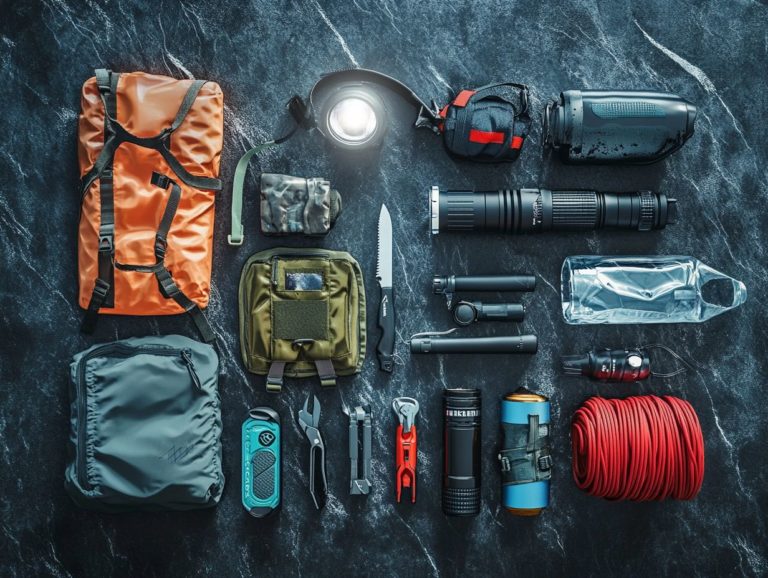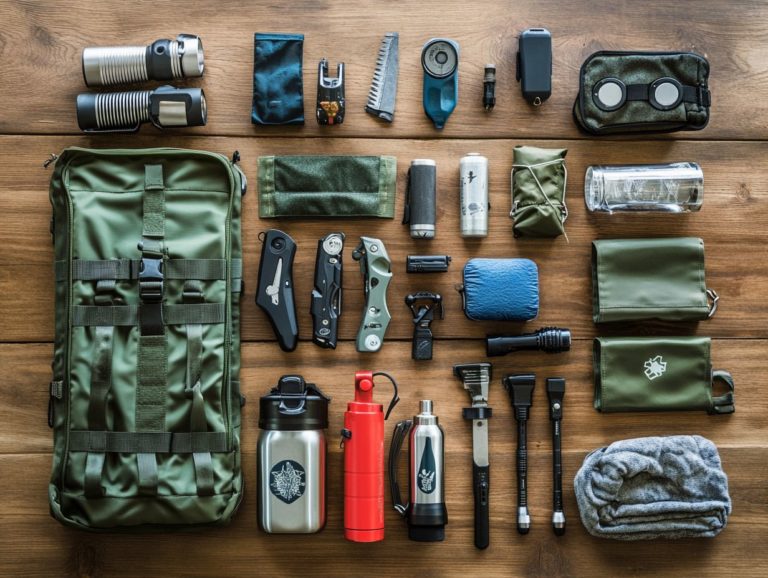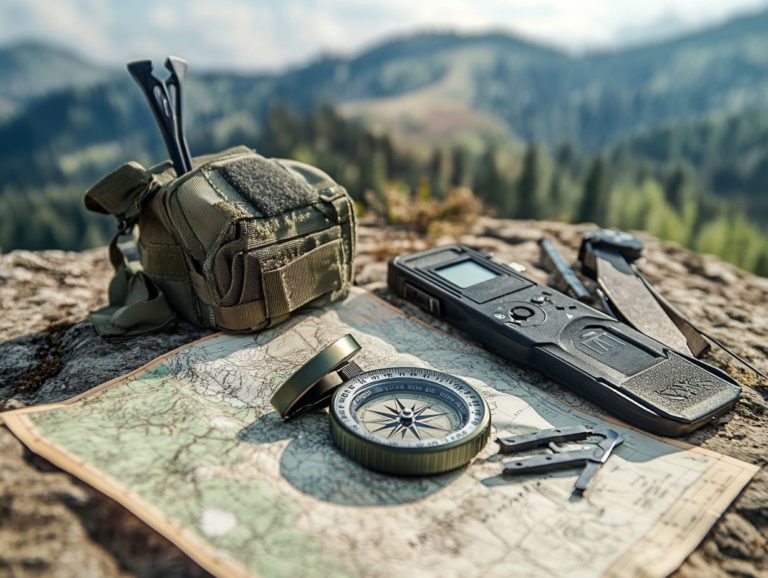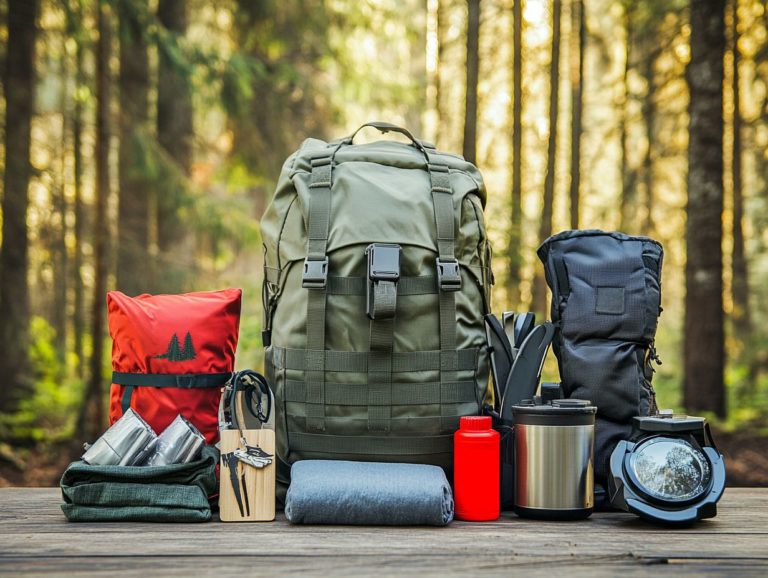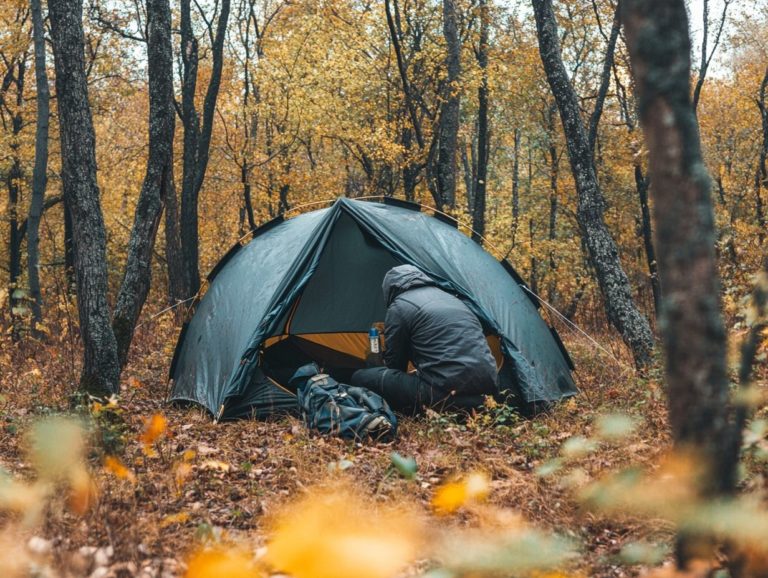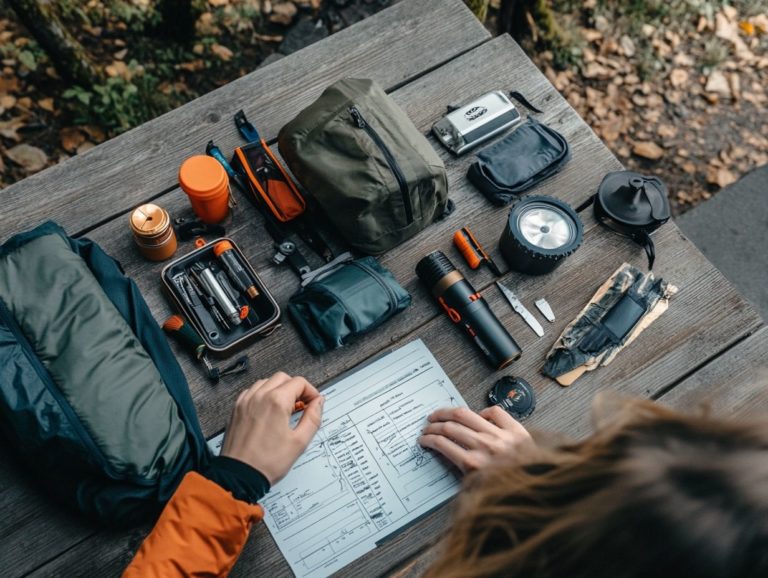The Best Survival Gear for Outdoor Skills Training
Planning an outdoor skills training adventure? The right survival gear is essential for a successful experience in the wild.
From the clothing you choose to your footwear, and from navigation tools to first aid kits, each piece of equipment plays a pivotal role in ensuring your safety and comfort. This guide outlines the must-have items you’ll need to tackle any outdoor challenge, guaranteeing that you’re well-prepared for your next expedition.
Dive in to discover the ultimate gear tailored to meet your survival needs!
Contents
- Key Takeaways:
- 1. Essential Clothing and Footwear
- 2. Navigation Tools
- 3. First Aid Kit
- 4. Shelter and Sleeping Gear
- 5. Fire Starting Tools
- 6. Water Filtration and Purification
- 7. Food and Cooking Supplies
- 8. Multi-Tool or Knife
- 9. Personal Hygiene Items
- 10. Emergency Communication Device
- 11. Lighting Equipment
- 12. Protection Against Insects and Wildlife
- 13. Repair and Maintenance Tools
- 14. Survival Books and Guides
- 15. Additional Gear for Specific Environments or Activities
- Frequently Asked Questions
- What is the best type of survival gear for outdoor skills training?
- What essential gear is recommended for outdoor skills training?
- Is it necessary to have expensive gear for outdoor skills training?
- What are some essential items to pack for outdoor skills training?
- Do I need to have prior experience to participate in outdoor skills training?
- What should I look for when purchasing survival gear?
- Are there any additional items that can enhance my outdoor skills training experience?
Key Takeaways:

- Always have the essential clothing and footwear for outdoor skills training to stay comfortable and protected from the elements.
- Navigation tools are crucial for staying on track and reaching your destination safely while training in outdoor environments.
- Be prepared for potential injuries with a well-stocked first aid kit, including items such as bandages, painkillers, and antiseptic wipes.
1. Essential Clothing and Footwear
When you venture into the wilderness for a survival adventure, choosing the right clothing and footwear is crucial for your comfort and protection against nature s whims. Essential clothing items for your journey should include moisture-wicking base layers, insulating mid-layers, and weather-resistant outer layers.
Your footwear must prioritize durability and traction to help you navigate diverse terrains. Think about how to keep warm, dress in layers, and carry your emergency gear without feeling weighed down.
Selecting the right materials is key, as they can significantly impact your performance and comfort. For example, synthetic fabrics wick moisture away from your skin, while wool provides natural insulation even when wet.
Layering helps you manage heat and gives you the flexibility to adjust to changing weather conditions. When traversing rocky paths or muddy trails, shoes with aggressive tread patterns and waterproofing are essential for your safety and support.
To round out your gear, consider incorporating survival essentials like:
- Portable water purifiers
- Multi-tools
- Emergency first-aid kits
Having these items on hand is invaluable, ensuring you’re prepared for whatever unexpected situations may arise.
Effective navigation tools are essential for your outdoor explorations. They enable you to traverse unfamiliar terrains with confidence and safety. Your survival kit should include must-have navigation tools like compasses, maps, and GPS devices, alongside life-saving essentials such as a signaling mirror and whistle to communicate your location in emergencies.
Understanding how to use each tool effectively enhances your navigation skills. Compasses provide reliable direction, while traditional maps help visualize landscapes and plan routes based on terrain contours.
GPS devices offer precise locations and track your movements, but since they rely on batteries, it s crucial to know how to switch back to traditional methods if needed.
By mastering these tools and incorporating them into a well-rounded survival kit, you enhance your navigation capabilities and significantly increase your chances of returning safely from any adventure.
Get your gear ready and embark on your adventure today!
3. First Aid Kit
A well-stocked first aid kit is essential for survival gear. It provides vital supplies for handling injuries and emergencies during outdoor activities.
Personalizing the kit to fit your health needs will boost its effectiveness. For instance, if you re prone to insect bites, include antihistamines and specialized creams.
If you have a heart condition, don t forget to pack the necessary medications. Regular upkeep is equally important; check your kit every few months to ensure nothing is expired.
This will guarantee you have an ample supply of critical items like sticky bandages and ointments.
Think about the potential risks associated with the environments you plan to explore whether it’s rugged mountains or tranquil coastlines. Equip your kit with specialized gear, such as snake bite kits or marine-specific treatments.
Make sure your first aid kit is ready today. You never know what adventures await!
4. Shelter and Sleeping Gear
Establishing a reliable shelter and equipping yourself with the right sleeping gear are essential for wilderness survival. These elements offer protection from the elements and ensure you enjoy a restorative night s rest.
Include critical items like an emergency blanket, plastic sheeting, and durable tarps in your survival kit. These tools enable you to construct a shelter tailored to your needs in various conditions.
When weighing your shelter options, consider everything from temporary structures like lean-tos and debris huts to more enduring solutions such as log cabins. Each type has its own set of advantages, depending on your environment and materials at hand.
Insulation plays a vital role, helping you retain body heat during chilly nights. Selecting the right sleeping bag for the temperature range can greatly enhance your comfort and warmth.
A good night’s sleep is not just a luxury; it s critical for maintaining mental acuity and sharpening your survival skills. Staying alert and resourceful is vital for your survival!
5. Fire Starting Tools
Fire-starting tools are critical for wilderness survival, acting as a cornerstone for warmth, cooking, and signaling for help. Incorporating tools like a magnesium block, an exoTAC fireROD, or a Spark Lite into your survival kit ensures you have reliable means to ignite a fire.
Mastering various fire-starting techniques such as friction, spark, and chemical methods can significantly impact your success rate in the wild. For example, while the bow drill method may work well in dry conditions, matches or lighters may be more dependable in damp environments.
In survival situations, your ability to start a fire provides essential warmth as well as a sense of security and comfort. Gathering tinder like dry grass or bark and larger fuel sources, such as logs or branches, is crucial; prepare these materials in advance.
Always keep fire safety in mind: establish a clear fire perimeter and ensure that ashes are completely extinguished to prevent wildfires.
6. Water Filtration and Purification
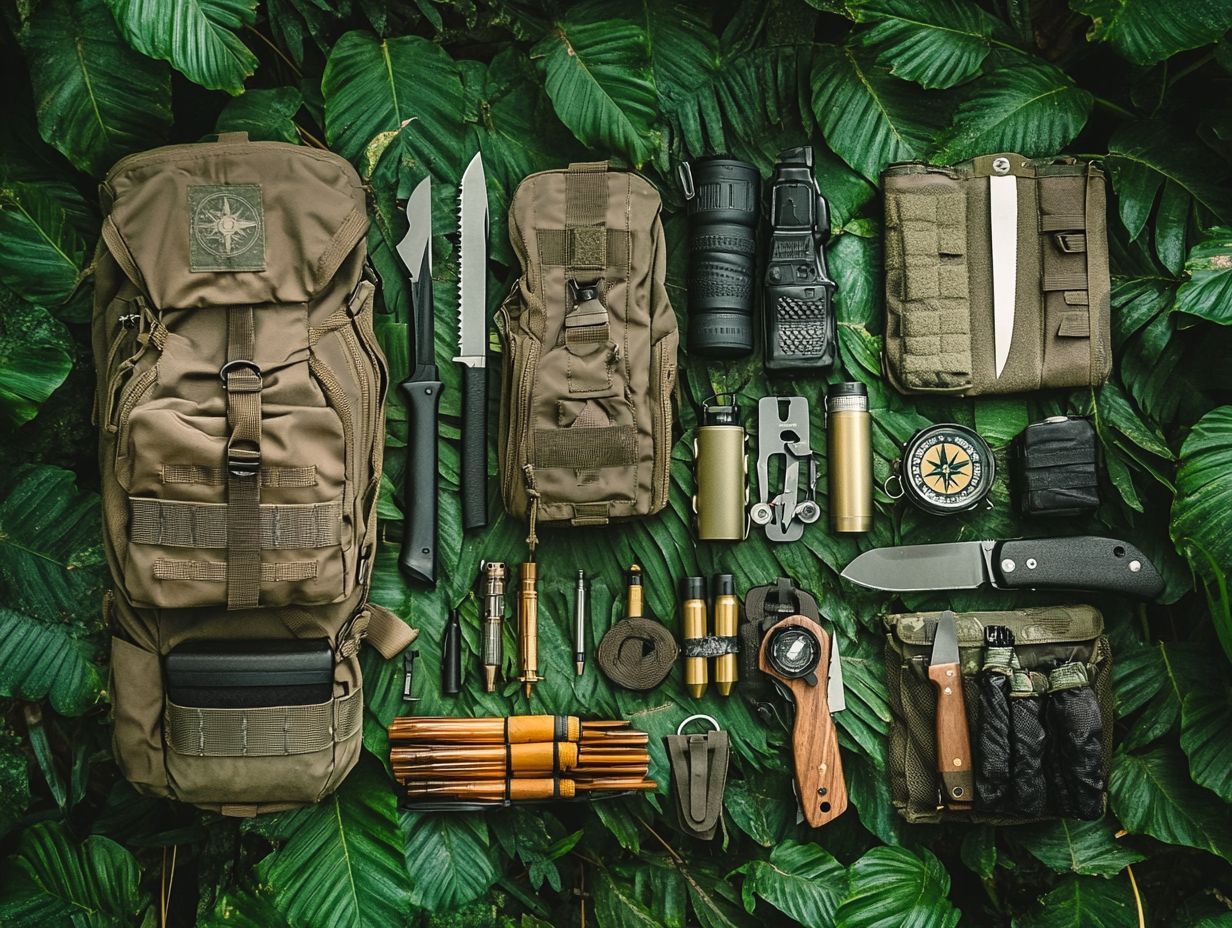
Water procurement is a top survival need in the wilderness. Effective filtration and purification methods are crucial for safe drinking water.
In addition to tablets, use portable filters, UV light devices, and boiling techniques. These methods can greatly enhance water safety.
However, filters may not eliminate viruses. Boiling requires a heat source and time.
Look for clear streams or rivers; running water is generally safer than stagnant pools. Staying hydrated is vital, as dehydration can harm your physical and mental functions.
7. Food and Cooking Supplies
Access to food and reliable cooking supplies is essential in wilderness survival. Your gear should include emergency rations packed with essential nutrients.
Familiarize yourself with foraging techniques. Nature offers edible plants, berries, and mushrooms to supplement your rations.
Cooking methods like boiling, steaming, and roasting can work with makeshift equipment. This reduces the risk of foodborne illnesses and preserves nutrients.
Use a minimal amount of fuel to prepare meals to extend your supplies. Establish a clean cooking area to avoid attracting wildlife.
8. Multi-Tool or Knife
A multi-tool or fixed-blade knife is a must-have in your survival kit. It provides various functions for outdoor tasks and emergencies.
Choosing the right tool means navigating diverse options. Compact multi-tools merge pliers, screwdrivers, and blades, while robust fixed-blade knives tackle heavy-duty tasks.
Store tools in protective sheaths and keep them dry. Regular maintenance prevents accidents and rust.
9. Personal Hygiene Items
Maintaining personal hygiene during wilderness survival is essential for your health and well-being. By including vital items like biodegradable soap, a toothbrush, and sanitary wipes in your survival kit, you can stay clean and prevent infections while exploring the great outdoors.
Regularly washing your hands, especially before meals or after tending to wounds, is critical. This simple action minimizes the risk of illness and ensures the safety of your food. Neglecting hygiene can threaten your chances of survival due to skin irritations or infections.
To effectively weave hygiene into your survival routine, set aside time each day for cleaning tasks. Whether it s bathing in streams, scrubbing your teeth, or using sanitizing wipes, practicing these habits boosts your physical health and uplifts your morale, making your wilderness experience far more enjoyable.
10. Emergency Communication Device
Having an emergency communication device is essential for anyone venturing into the wilderness. It helps you signal for help when you need it most. Enhancing your survival kit with tools like a signaling mirror and a whistle can significantly boost your chances of being located during emergencies.
These devices not only provide immediate communication but also act as a vital lifeline when traditional methods fall short. If mobile networks fail, an emergency radio can connect you with rescue teams, while a GPS device ensures accurate location tracking.
Mastering the use of these tools can dramatically increase your chances of rescue, making it imperative to practice your signaling techniques. By understanding different types of survival gear and combining them effectively, you can elevate your survival skills in critical situations.
11. Lighting Equipment
Proper lighting equipment is essential for your wilderness survival, enabling you to navigate and complete vital tasks after dark. A reliable flashlight or headlamp should be a key component of your survival kit, ensuring you maintain visibility and safety during nighttime adventures.
Lanterns and glow sticks also make for excellent supplementary lighting options. Lanterns offer broader illumination, perfect for lighting up your campsite, while glow sticks can be invaluable for marking paths or signaling for help.
Consider the angle of your lighting to reduce shadows and improve visibility.
Want to stay safe after dark? Keep these lighting tips in mind:
- Regularly check your batteries before venturing into the wild.
- Use red filters on flashlights to preserve your night vision.
- Keep your lighting equipment within easy reach.
By prioritizing various types of lighting and understanding how to apply them effectively, you can significantly boost your safety and comfort in survival situations.
12. Protection Against Insects and Wildlife
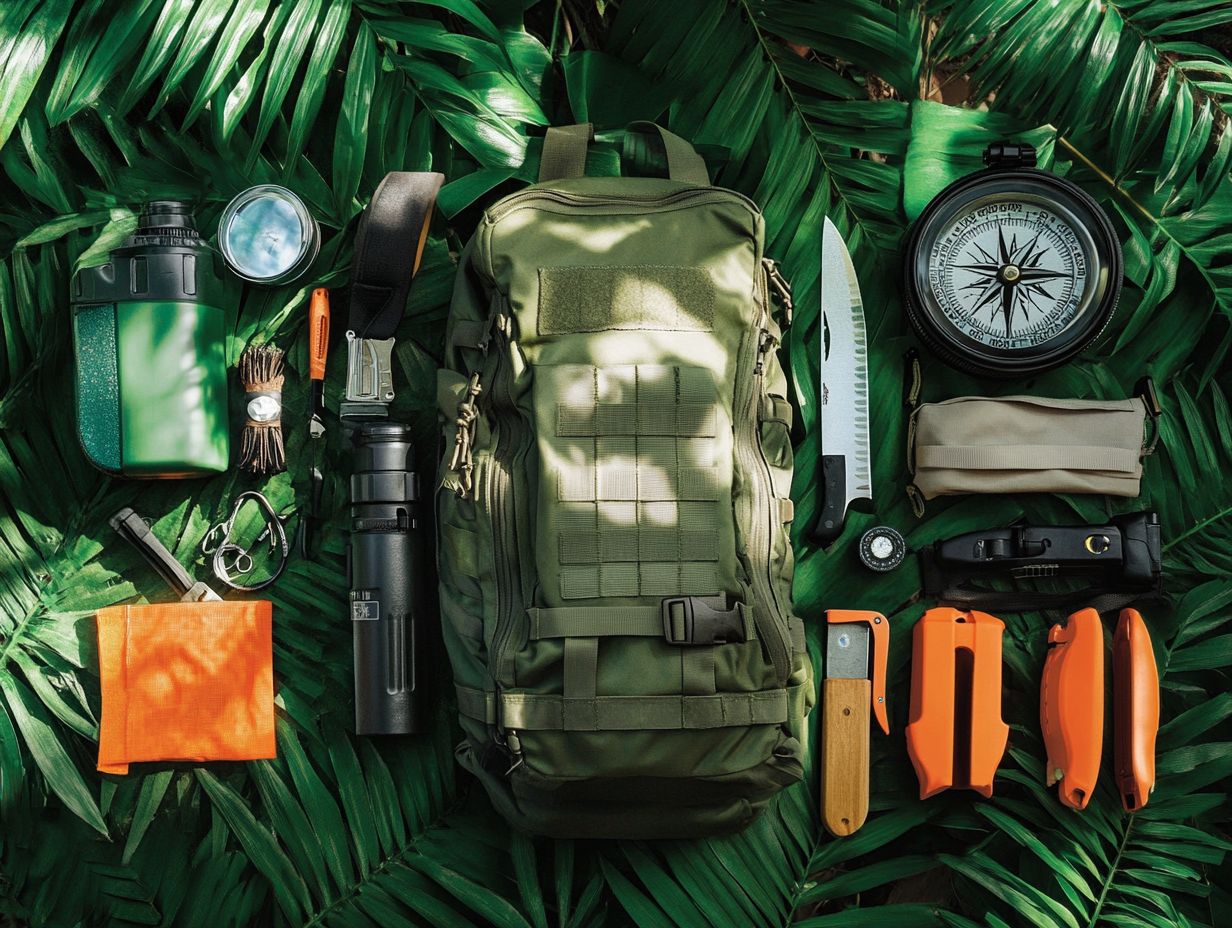
Protection against insects and wildlife is vital for staying safe in the wild. Incorporating items like insect repellent and bear spray into your survival gear can help avert encounters, ensuring a more secure outdoor experience.
Packing the right tools is important, but knowing how to use them effectively is key. For instance, choose a campsite away from established animal trails and store food properly in airtight containers or special containers that keep food safe from bears. To ensure you’re well-prepared, consider learning where to buy the best survival gear online. These measures can significantly diminish the likelihood of unexpected visits from wildlife.
Minimizing food odors by cooking and storing meals away from sleeping areas not only enhances your safety but also creates an environment less appealing to insects. By following these tips, you can explore nature confidently and comfortably.
13. Repair and Maintenance Tools
The right repair and maintenance tools can be your best friends in the wild! They are crucial for wilderness survival, allowing you to address equipment and gear issues as they arise. Including essentials like duct tape, spare cordage, and multi-tools in your survival kit ensures you re fully prepared for unexpected challenges.
These tools not only equip you to handle immediate repairs but also significantly extend the lifespan of your essential gear. For instance, a reliable multi-tool that combines several functions like cutting and screwing can help you tighten loose screws, cut through various materials, or even create makeshift solutions on the fly. Similarly, repair patches can seal leaks in tents or sleeping bags, providing vital comfort and protection from the elements. To enhance your outdoor experience, consider the top 7 survival gear items for the wilderness that every adventurer should have.
Having a fire starter kit with spare tinder helps you cook and stay warm outdoors. Together, these items enhance your readiness to tackle unforeseen problems, ensuring a safer and more enjoyable wilderness experience. To further boost your preparedness, consider the top survival tools for emergency preparedness.
14. Survival Books and Guides
Survival books and guides are your critical companions as an outdoor enthusiast. They equip you with essential knowledge and skills for navigating the wilderness. These resources prepare you for various survival scenarios, offering insights into effective tactics and emergency preparedness.
They delve into crucial topics, from recognizing local flora and fauna to mastering fundamental skills like fire-making, shelter construction, and foraging for food. Given the unpredictable nature of the outdoors, having printed survival guides handy ensures you can swiftly access vital information without needing to rely on electronic devices. Additionally, understanding the top 10 survival gear for wilderness adventures can enhance your preparedness significantly.
By regularly studying these materials, you can enhance your situational awareness and build confidence in your abilities, making you better equipped to handle potential emergencies. Additionally, having the best survival gear for preppers can further prepare you for whatever your adventures may bring.
15. Additional Gear for Specific Environments or Activities
When you embark on specific adventures or delve into unique environments, having the right additional gear is crucial for successful wilderness survival. Customizing your survival kit to include specialized equipment tailored to the terrain, climate, or type of exploration can greatly enhance your capabilities and ensure your safety.
To effectively assess your environment and activities, consider factors such as elevation, weather conditions, and the duration of your journey. For example, if climbing is on your agenda, essential gear like harnesses, carabiners, and climbing ropes will be critical. Additionally, having the right equipment from the top 5 survival gear kits for beginners can enhance your safety and preparedness.
If you find yourself traversing snowy landscapes, investing in cold-weather essentials such as insulated jackets, snowshoes, and avalanche safety equipment is imperative. Additionally, when considering top features to look for in survival gear, in marine environments, you’ll need floating devices and dry bags to keep yourself safe and protected from water exposure.
By recognizing the specific demands of each adventure, you can make informed decisions about the additional gear you ll require, setting yourself up for success in the great outdoors.
Frequently Asked Questions
What is the best type of survival gear for outdoor skills training?
Consider joining a survival class to learn hands-on techniques that can be crucial for your adventures.
What essential gear is recommended for outdoor skills training?

The best type of survival gear for outdoor skills training depends on the specific skills being taught and the environment in which the training will take place. Some essential gear includes a survival knife, a water filtration system, a first aid kit, and a fire starter tool.
Is it necessary to have expensive gear for outdoor skills training?
No, it is not necessary to have expensive gear for outdoor skills training. While high-quality gear can be beneficial, there are many affordable options that perform just as well. The most important factor is to have reliable gear that suits your specific needs.
What are some essential items to pack for outdoor skills training?
Some essential items include a map and compass, a headlamp or flashlight, a multi-tool, and a water bottle.
Bring enough food and water to keep you going during the training exercises.
Do I need to have prior experience to participate in outdoor skills training?
No, you don t need experience for outdoor skills training. These programs are perfect for all skill levels, including beginners.
Inform the instructors about any health concerns or limitations before you start.
What should I look for when purchasing survival gear?
Look for gear that is durable, lightweight, and can do many things.
Consider your specific needs and the environment where you ll be training, and check the brand s reputation and reviews.
Are there any additional items that can enhance my outdoor skills training experience?
Absolutely! Some exciting items can really boost your outdoor skills training.
Consider a portable stove for cooking, a hammock for resting comfortably, or a waterproof notebook for taking notes and journaling during your training.

